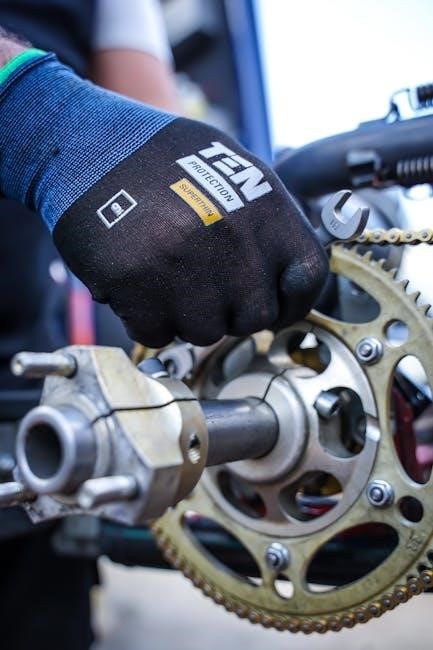guide chain sprocket
Guide chain sprockets are toothed wheels that engage chain links, providing stability and support in mechanical systems. They ensure smooth power transmission and motion control.
1.1 Definition and Basic Function
A guide chain sprocket is a toothed wheel designed to engage and guide chains in mechanical systems. Its primary function is to transmit rotational motion and torque efficiently by aligning chain links precisely with its teeth, ensuring smooth operation and minimizing wear.
1.2 Importance in Mechanical Systems
Guide chain sprockets are essential for efficient power transmission in mechanical systems. They ensure precise chain alignment, reducing wear and increasing system lifespan. Their role in converting rotational motion and torque makes them critical for conveyors, drivetrains, and industrial machinery, enhancing reliability and performance across various applications.
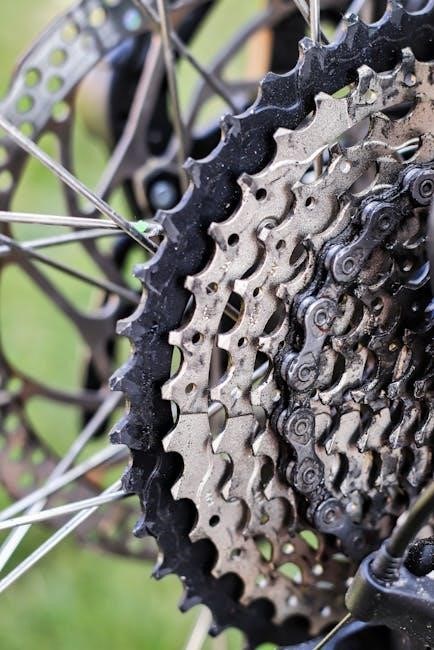
Types of Sprockets
Sprockets come in various types, such as roller chain, idler, and guide sprockets, each designed for specific roles in power transmission and chain management systems.
2.1 Roller Chain Sprockets
Roller chain sprockets are toothed wheels designed to engage roller chains in power transmission systems. They efficiently transfer torque and motion, ensuring reliability in applications with controlled loads. Proper alignment and maintenance are crucial for longevity and optimal performance in industrial machinery and conveyor systems.
2.2 Idler Sprockets
Idler sprockets are non-driving components used to guide and manage chain slack in systems where chain adjustment isn’t feasible. They don’t transmit power but ensure proper chain alignment and tension, preventing wear. Often used in long-chain applications or around obstructions, idler sprockets maintain smooth operation without adding torque, making them essential for system efficiency and reliability.
2.3 Guide Sprockets
Guide sprockets are designed to maintain proper chain alignment and prevent derailment. They feature smooth surfaces or specific designs to guide the chain without engaging it for power transmission. Often used in applications requiring precise chain control, guide sprockets enhance system reliability. Made from durable materials like aluminum, they ensure consistent performance, especially in high-speed or precision-driven environments, where chain stability is critical for optimal operation.
Materials and Manufacturing
Guide chain sprockets are typically made from durable materials like aluminum and steel. Advanced manufacturing processes, including CNC machining, ensure precise tooth profiles and structural integrity for optimal performance.
3.1 Common Materials Used
Guide chain sprockets are typically crafted from high-strength materials such as steel, aluminum, and durable plastics. Steel is favored for its robustness and resistance to wear, while aluminum offers lightweight durability. Plastics are often used in lighter applications. These materials ensure longevity and efficiency in mechanical systems, supporting smooth chain engagement and torque transmission effectively.
3.2 Manufacturing Process
The manufacturing of guide chain sprockets involves precision machining to ensure accurate tooth profiles and alignment. High-strength materials like steel or aluminum are cut and shaped using CNC machines. Heat treatment enhances durability and resistance to wear. A smooth finish is achieved through grinding or coating processes, ensuring optimal chain engagement and long service life in demanding applications.
Function and Purpose
Guide chain sprockets ensure smooth chain engagement and alignment, preventing derailment. They maintain consistent power transmission, enhancing system efficiency and reducing wear.
4.1 Engaging Chain Links
Guide chain sprockets precisely engage chain links, ensuring minimal wear and efficient power transfer. Their toothed design securely captures links, maintaining system alignment and stability during operation.
4.2 Transmitting Torque
Guide chain sprockets play a crucial role in transmitting torque efficiently. Their toothed design ensures consistent power transfer between the chain and connected components. Proper engagement minimizes slippage, maintaining system performance and reducing wear. This reliable torque transmission is essential in various mechanical systems, from industrial machinery to bicycles, ensuring smooth operation and optimal energy utilization across applications.
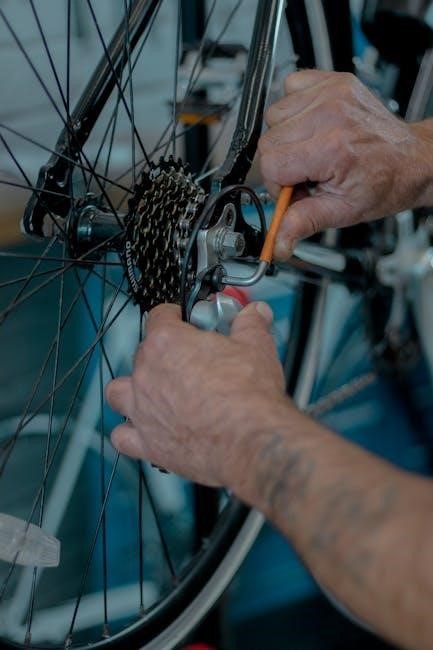
Maintenance and Care
Regular maintenance is essential for guide chain sprockets. This includes inspecting for wear, applying proper lubrication, and ensuring alignment to prevent premature damage and ensure longevity.
5.1 Lubrication Best Practices
Proper lubrication of guide chain sprockets is crucial for reducing friction and wear. Use high-quality lubricants suitable for the operating conditions. Apply lubricant to the chain and ensure it reaches the sprocket teeth. Regularly inspect and reapply as needed, avoiding over-lubrication, which can attract dirt. This practice extends component life and maintains efficient power transmission.
5.2 Inspecting for Wear
Regularly inspect guide chain sprockets for wear, such as worn or chipped teeth, cracks, or excessive clearance between the chain and sprocket. Misalignment or uneven wear can lead to chain slippage and reduced efficiency. Use precision tools or gauges to measure wear accurately. Replace worn sprockets promptly to prevent further damage to the chain and ensure smooth operation.
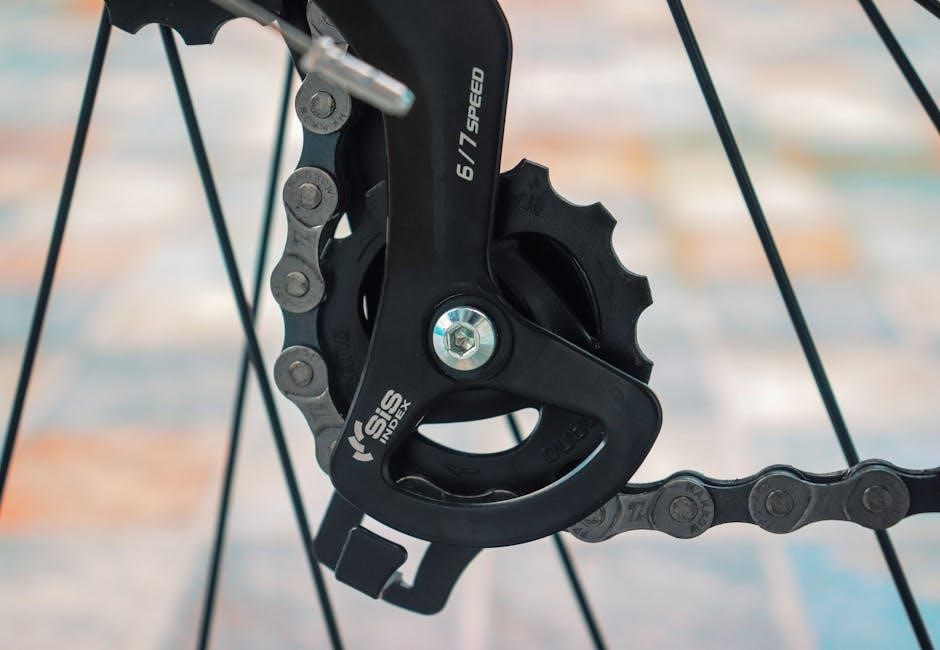
Applications Across Industries
Guide chain sprockets are widely used in industrial machinery, bicycles, and conveyor systems, ensuring efficient power transmission and smooth mechanical operations across various sectors.
6.1 Industrial Machinery
Guide chain sprockets are essential in industrial machinery for smooth power transmission and efficient operation. They are widely used in conveyor systems, manufacturing equipment, and heavy-duty applications. Durable materials and precise engineering ensure they handle high torque and load variations. Their ability to customize for specific industrial needs enhances productivity and reliability in various mechanical processes.
6.2 Bicycle Drivetrains
In bicycles, guide chain sprockets play a critical role in maintaining smooth chain movement and preventing derailment. Typically made from durable materials like aluminum, they ensure efficient power transfer from the pedals to the rear wheel. Their design allows for precise gear shifting and consistent performance, making them indispensable in both road and mountain biking applications.
Chain Guides and Their Role
Chain guides ensure smooth chain movement, preventing derailment and maintaining alignment with sprockets. They are crucial for efficient power transmission in both industrial and bicycle drivetrains.
7.1 Ensuring Smooth Chain Movement
Chain guides play a vital role in maintaining smooth chain movement by keeping the chain aligned with the sprockets. This alignment prevents derailment and reduces friction, ensuring efficient power transmission. Properly functioning guides minimize wear on both the chain and sprockets, contributing to the overall durability and performance of the mechanical system.
7.2 Reducing Wear and Tear
Guide chain sprockets minimize wear by maintaining proper chain alignment and reducing friction. This prevents excessive stress on the chain and sprocket teeth, extending their lifespan. Smooth chain movement reduces abrasion, while consistent tension prevents uneven wear. Properly functioning guides ensure even load distribution, safeguarding against premature degradation of the chain and sprocket system.
Idler Sprockets in Chain Systems
Idler sprockets manage chain slack and guide chains around obstructions without transmitting power. They are essential for maintaining proper chain tension and system efficiency in various applications.
8.1 Managing Chain Slack
Idler sprockets effectively manage chain slack by redirecting the chain’s path, ensuring proper tension and alignment. They are particularly useful in systems with long chain lengths or non-adjustable shafts, preventing excessive sagging or vibration. By guiding the chain around obstructions, idler sprockets maintain consistent power transmission and reduce wear on both the chain and sprockets, enhancing overall system efficiency and reliability.
8.2 Guiding Chains Around Obstructions
Idler sprockets are designed to guide chains around obstructions, ensuring smooth operation in complex systems. By redirecting the chain’s path, they prevent damage from sharp turns or collisions. This feature is crucial in applications with limited space or irregular layouts, maintaining chain alignment and reducing wear on both the chain and sprockets, thus enhancing overall system durability and performance.
Selecting the Right Sprocket
Selecting the right sprocket involves considering pitch, teeth count, and chain type compatibility. Proper selection ensures optimal performance, efficiency, and durability in mechanical systems.
9.1 Pitch and Teeth Count
The pitch refers to the distance between chain link centers, while teeth count determines the sprocket’s capacity to engage links. Proper alignment of these ensures smooth operation, reduces wear, and prevents premature failure. Accurate matching with the chain is crucial for efficient power transmission and system longevity.
9.2 Compatibility with Chain Type
Ensuring sprocket compatibility with the chain type is essential for optimal performance. Different chains, such as roller or conveyor chains, have specific requirements. Misalignment or incorrect pairing can lead to inefficiency, wear, and potential system failure. Proper matching guarantees smooth engagement, reduces noise, and extends the lifespan of both the sprocket and chain in the system.
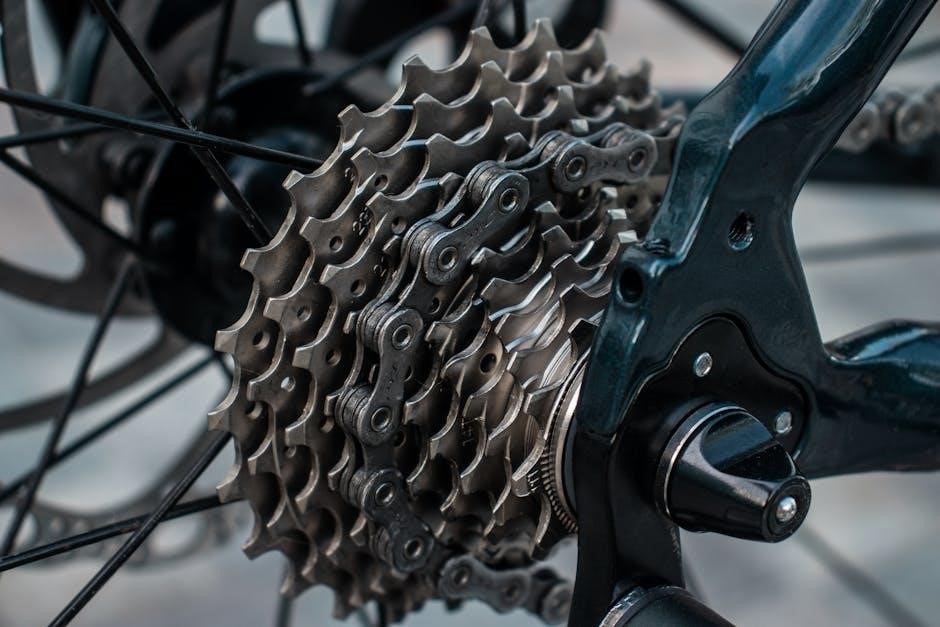
The Importance of Sprocket-Chain Alignment
Proper sprocket-chain alignment is crucial for smooth operation, preventing uneven wear and noise. It ensures efficient power transmission and extends system lifespan by minimizing mechanical stress.
10.1 Checking Alignment
Proper alignment ensures smooth chain movement and prevents wear. Use a straightedge or laser tool across sprocket teeth to verify parallelism. Misalignment causes uneven wear and noise. Regular checks maintain efficiency and extend component life.
10.2 Consequences of Misalignment
Misaligned sprockets lead to uneven chain wear, increased noise, and reduced system efficiency. Severe cases cause chain derailment, operational downtime, and premature sprocket failure, necessitating costly repairs and replacements. Proper alignment is crucial for optimal performance and longevity of chain and sprocket systems.
Guide chain sprockets are essential for smooth power transmission, ensuring efficiency and durability in various applications. Proper maintenance and alignment are key to their optimal performance and longevity.
11.1 Summary of Key Points
Guide chain sprockets are integral to mechanical systems, enabling smooth power transmission and motion control. They come in types like roller and idler sprockets, made from durable materials such as steel and aluminum. Proper lubrication and alignment are crucial for longevity. Regular inspection for wear ensures optimal performance. Their applications span industries, from machinery to bicycles, highlighting their versatility and importance in maintaining efficient systems.
11.2 Final Tips for Optimal Performance
For optimal performance, ensure proper alignment and lubrication of guide chain sprockets. Regularly inspect for wear and replace parts as needed. Choose materials and sizes that match your application. Maintain chain tension and alignment to prevent premature wear. Clean and lubricate frequently to reduce friction and extend lifespan. Always follow manufacturer guidelines for installation and maintenance.

